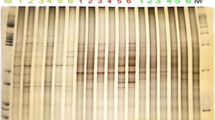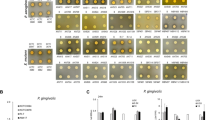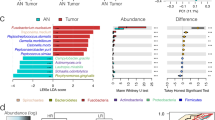Abstract
Information on co‐adherence of different oral bacterial species is important for understanding interspecies interactions within oral microbial community. Current knowledge on this topic is heavily based on pariwise coaggregation of known, cultivable species. In this study, we employed a membrane binding assay coupled with polymerase chain reaction‐denaturing gradient gel electrophoresis (PCR‐DGGE) to systematically analyze the co‐adherence profiles of oral bacterial species, and achieved a more profound knowledge beyond pairwise coaggregation. Two oral bacterial species were selected to serve as “bait”: Fusobacterium nucleatum (F. nucleatum) whose ability to adhere to a multitude of oral bacterial species has been extensively studied for pairwise interactions and Streptococcus mutans(S. mutans) whose interacting partners are largely unknown. To enable screening of interacting partner species within bacterial mixtures, cells of the “bait” oral bacterium were immobilized on nitrocellulose membranes which were washed and blocked to prevent unspecific binding. The “prey” bacterial mixtures (including known species or natural saliva samples) were added, unbound cells were washed off after the incubation period and the remaining cells were eluted using 0.2 mol·L−1 glycine. Genomic DNA was extracted, subjected to 16S rRNAPCR amplification and separation of the resulting PCR products by DGGE. Selected bands were recovered from the gel, sequenced and identified via Nucleotide BLAST searches against different databases. While few bacterial species bound to S. mutans, consistent with previous findings F.nucleatum adhered to a variety of bacterial species including uncultivable and uncharacterized ones. This new approach can more effectively analyze the co‐adherence profiles of oral bacteria, and could facilitate the systematic study of interbacterial binding of oral microbial species.
Similar content being viewed by others
Article PDF
Author information
Authors and Affiliations
Corresponding author
Rights and permissions
About this article
Cite this article
Wang, R., He, X., Hu, W. et al. Analysis of interspecies adherence of oral bacteria using a membrane binding assay coupled with polymerase chain reaction‐denaturing gradient gel electrophoresis profiling. Int J Oral Sci 3, 90–97 (2011). https://doi.org/10.4248/IJOS11033
Received:
Accepted:
Published:
Issue date:
DOI: https://doi.org/10.4248/IJOS11033
Keywords
This article is cited by
-
Effect of SrtA on Interspecies Adherence of Oral Bacteria
Current Medical Science (2018)
-
Inhibition of Streptococcus mutans biofilm formation, extracellular polysaccharide production, and virulence by an oxazole derivative
Applied Microbiology and Biotechnology (2016)



